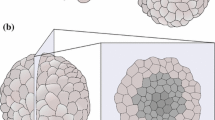Abstract
A mathematical model is proposed to explain the observed internalization of microspheres and 3H-thymidine labelled cells in steady-state multicellular spheroids. The model uses the conventional ideas of nutrient diffusion and consumption by the cells. In addition, a very simple model of the progress of the cells through the cell cycle is considered. Cells are divided into two classes, those proliferating (being in G 1, S, G 2 or M phases) and those that are quiescent (being in G 0). Furthermore, the two categories are presumed to have different chemotactic responses to the nutrient gradient. The model accounts for the spatial and temporal variations in the cell categories together with mitosis, conversion between categories and cell death. Numerical solutions demonstrate that the model predicts the behavior similar to existing models but has some novel effects. It allows for spheroids to approach a steady-state size in a non-monotonic manner, it predicts self-sorting of the cell classes to produce a thin layer of rapidly proliferating cells near the outer surface and significant numbers of cells within the spheroid stalled in a proliferating state. The model predicts that overall tumor growth is not only determined by proliferation rates but also by the ability of cells to convert readily between the classes. Moreover, the steady-state structure of the spheroid indicates that if the outer layers are removed then the tumor grows quickly by recruiting cells stalled in a proliferating state. Questions are raised about the chemotactic response of cells in differing phases and to the dependency of cell cycle rates to nutrient levels.
Similar content being viewed by others
References
Burton, A. (1966). Rate of growth of solid tumors as a problem of diffusion. Growth 30, 157–176.
Byrne, H. and M. Chaplain (1995). Growth of nonnecrotic tumors in the presence and absence of inhibitors. Math. Biosci. 130, 151–181.
Byrne, H. and S. Gourley (1997). The role of growth factors in avascular tumour growth. Math. Comput. Modelling 26, 35–55.
Chaplain, M. (1996). Avascular growth, angiogenesis and vascular growth in solid tumours: The mathematical modelling of the stages of tumour development. Math. Comput. Modelling 23, 47–87.
Chaplain, M. and N. Britton (1993). On the concentration profile of a growth inhibitory factor in multicell spheroids. Math. Biosci. 115, 233–243.
Dorie, M., R. Kallman and M. Coyne (1986). Effect of cytochalasin b, nocodazole and irradiation on migration and internalization of cells and microspheres in tumor cell spheroids. Exp. Cell Res. 166, 370–378.
Dorie, M., R. Kallman, D. Rapacchietta, D. van Antwerp and Y. Huang (1982). Migration and internalization of cells and polystrene microspheres in tumor cell spheroids. Exp. Cell Res. 141, 201–209.
Greenspan, H. (1972). Models for the growth of a solid tumor by diffusion. Stud. Appl. Math. 51, 317–340.
Greenspan, H. (1976). On the growth and stability of cell cultures and solid tumors. J. Theor. Biol. 56, 229–242.
Hughes, F. and C. McCulloch (1991). Quantification of chemotactic response of quiescent and proliferating fibroblasts in boyden chambers by computer-assisted image analysis. J. Histochem. Cytochem. 39, 243–246.
Knuechel, R. and R. Sutherland (1990). Recent developments in research with human tumor spheroids. Cancer J. 3, 234–243.
Kunz-Schugart, L., M. Kreutz and R. Knuechel (1998). Multicellular spheroids: A three-dimensional in vitro culture system to study tumour biology. Int. J. Exp. Pathol. 79, 1–23.
Landman, K. A. and C. Please. Tumour dynamics and necrosis: Surface tension and stability. IMAJ. Math. Appl. Med. Biol. (submitted).
Mansbridge, J., R. Knuechel, A. Knapp and R. Sutherland (1992). Importance of tyrosine phosphates in the effects of cell-cell contact and microenvironments on egf-stimulated tyrosine phosphorylation. J. Cell. Physiol. 1, 433–442.
McElwain, D. and G. Pettet (1993). Cell migration in multicell spheroids: Swimming against the tide. Bull. Math. Biol. 55, 655–674.
Mueller-Klieser, W. (1997). Three-dimensional cell cultures: From molecular mechanisms to clinical applications. Am. J. Physiol. 273:4, 1109–1123.
Mueller-Klieser, W. and J. Freyer (1986). Influence of glucose and oxygen supply conditions on the oxygenation of multicellular spheroids. Br. J. Cancer 53, 345–353.
Mueller-Klieser, W. and R. Sutherland (1982). Oxygen tensions in multicell spheroids of two cell lines. Br. J. Cancer 45, 256–264.
Murray, J. (1993). Mathematical Biology, 2nd edn, New York: Springer Verlag.
Palka, J., B. Adelmann-Grill, P. Francz and K. Bayreuther (1996). Differentiation stage and cell cycle position determine the chemotactic response of fibroblasts. Folia Histochem. Cytobiol. 34, 121–127.
Please, C., G. Pettet and D. McElwain (1998). A new approach to modelling the formation of necrotic regions in tumours. Appl. Math. Lett. 11, 89–94.
Please, C., G. Pettet and D. McElwain (1999). Avascular tumour dynamics and necrosis. Math. Models Methods Appl. Sci. 9, 569–579.
Roe, P. (1985). Some contributions to the modelling of discontinuous flows, in Large-scale Computations in Fluid Mechanics, Lectures in Applied Mathematics 22, B. Engquist, S. Osher and R. Somerville (Eds), Providence, RI: American Mathematical Society, pp. 163–193.
Sutherland, R. (1988). Cell and environment interactions in tumor microregions: The multicell spheroid model. Science 240, 177–184.
Thompson, K. and H. Byrne (1999). Modelling the internalisation of labelled cells in tumour spheroids. Bull. Math. Biol. 61, 601–623.
Toro, E. (1989). A weighted average flux method for hyperbolic conservation laws. Proc. R. Soc. Lond. A 423, 401–418.
Tubiana, M. (1971). The kinetics of tumour cell proliferation and radiotherapy. Br. J. Radiol. 44, 325–347.
Ward, J. and J. King (1998a). Mathematical modelling of avascular-tumour growth ii: Modelling growth saturation. IMA J. Math. Appl. Med. Biol. 15, 1–42.
Ward, J. and J. King (1998b). Mathematical modelling of the effects of mitotic inhibitors on avascular tumour growth. J. Theor. Med. 1–25.
Author information
Authors and Affiliations
Rights and permissions
About this article
Cite this article
Pettet, G.J., Please, C.P., Tindall, M.J. et al. The migration of cells in multicell tumor spheroids. Bull. Math. Biol. 63, 231–257 (2001). https://doi.org/10.1006/bulm.2000.0217
Received:
Accepted:
Issue Date:
DOI: https://doi.org/10.1006/bulm.2000.0217




